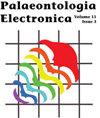墨西哥伊达尔戈Sanctórum古阿马亚克湖的一条上新世好鱼
IF 1.5
4区 地球科学
Q1 Earth and Planetary Sciences
引用次数: 0
摘要
根据对墨西哥伊达尔戈Sanctórum古阿马亚克湖上新世沉积物中发现的14个雌雄化石标本的骨学研究,建立了古马尼亚古裂片化石种古马尼亚古特征龙gen. and sp. 11 .。这一新棘齿鱼表现出鳖科和鳖亚科的诊断特征;与所有的好齿类一样,其前颌远端直,前颌上突小;而且,像古德尼鱼一样,这个新物种是胎生的,它的第一个肛门鳍是初级的,雄性有一个雄蕊柱体。尽管古氏古猿显示出许多原始特征,但不可能将其归入任何古迪恩部落,目前这些古迪恩部落是由骨学特征模糊定义的。这个新种似乎与characterodon有密切的亲缘关系;两者都有一种特殊的骨学特征;方椎体的关节突是一个环状结构,其中关节后形成中心区域,几个半圆形关节外突形成周围部分。本种不同于其他好蛛主要有两个特征;它有颞骨和小的前腹突,其眶上管开口显示公式12a, 2b-3a, 3b-4a, 4b-5a和5b-7。在墨西哥领土东坡的Pánuco-Salado大盆地中发现的这种已灭绝的优良物种代表了一个意想不到的历史因素。卡门Caballero-Vinas。墨西哥国立大学Autónoma Geología研究所Paleontología系。墨西哥墨西哥城,04510,墨西哥,墨西哥,墨西哥,墨西哥,墨西哥,墨西哥,墨西哥,墨西哥,墨西哥,墨西哥,墨西哥,墨西哥,墨西哥,墨西哥,墨西哥c-caballero@live.com.mx Jesús阿尔瓦拉多-奥尔特加。墨西哥国立大学Autónoma Geología研究所Paleontología系。电子线路Investigación s.s.n, Ciudad Universitaria, Coyoacán, Ciudad de msamico, 04510, msamico。alvarado@geologia.unam。克雷顿·马格诺·坎塔利斯·塞维利亚诺。Paleontología系,Geología研究所,CABALLERO-VIÑAS等:上新世古数据来自墨西哥2国家Autónoma de msamxico。电子线路Investigación s.s.n, Ciudad Universitaria, Coyoacán, Ciudad de msamico, 04510, msamico。kleytonmc@geologia.unam.mx本文章由计算机程序翻译,如有差异,请以英文原文为准。
A Pliocene goodeid fish of the Paleolake Amajac, Sanctórum, Hidalgo, Mexico
The splitfin fossil species Paleocharacodon guzmanae gen. and sp. nov. is erected based on the osteological study of 14 fossil male and female specimens recovered in the Pliocene deposits of the Paleolake Amajac, in Sanctórum, Hidalgo, Mexico. This new cyprinodontiform fish exhibits the diagnostic features of the family Goodeidae and subfamily Goodeinae; like all the goodeids, its premaxilla has a straight distal end, and its premaxillary ascending process is small; and, like the goodeines, this new species was viviparous, its first anal fin ray is rudimentary, and the males show an andropodium. Although P. guzmanae displays numerous primitive features, it is not possible to place it in any of the goodeine tribes, which currently are vaguely defined by osteological features. This new species seems to be closely related to Characodon; both share a peculiar osteological character; the articular facet for the quadrate is a donut-like structure, in which the retroarticular forms the central region, and a couple of semicircular anguloarticular processes form the surrounding part. This species differs from other goodeids mainly in two features; it has a posttemporal bone with small anteroventral processes, and the openings of its supraorbital canal show the formula12a, 2b-3a, 3b-4a, 4b-5a, and 5b-7. The discovery of this extinct goodeid species in the great Pánuco-Salado Basin on the eastern slope of Mexican territory represents an unexpected historical element. Carmen Caballero-Viñas. Departamento de Paleontología, Instituto de Geología, Universidad Nacional Autónoma de México. Circuito de la Investigación S/N, Ciudad Universitaria, Coyoacán, Ciudad de México, 04510, Mexico. c-caballero@live.com.mx Jesús Alvarado-Ortega. Departamento de Paleontología, Instituto de Geología, Universidad Nacional Autónoma de México. Circuito de la Investigación S/N, Ciudad Universitaria, Coyoacán, Ciudad de México, 04510, México. alvarado@geología.unam.mx Kleyton Magno Cantalice Severiano. Departamento de Paleontología, Instituto de Geología, Universidad CABALLERO-VIÑAS ET AL.: PLIOCENE GOODEID FROM MEXICO 2 Nacional Autónoma de México. Circuito de la Investigación S/N, Ciudad Universitaria, Coyoacán, Ciudad de México, 04510, México. kleytonmc@geologia.unam.mx
求助全文
通过发布文献求助,成功后即可免费获取论文全文。
去求助
来源期刊

Palaeontologia Electronica
地学-古生物学
CiteScore
3.60
自引率
0.00%
发文量
20
审稿时长
>12 weeks
期刊介绍:
Founded in 1997, Palaeontologia Electronica (PE) is the longest running open-access, peer-reviewed electronic journal and covers all aspects of palaeontology. PE uses an external double-blind peer review system for all manuscripts. Copyright of scientific papers is held by one of the three sponsoring professional societies at the author''s choice. Reviews, commentaries, and other material is placed in the public domain. PE papers comply with regulations for taxonomic nomenclature established in the International Code of Zoological Nomenclature and the International Code of Nomenclature for Algae, Fungi, and Plants.
 求助内容:
求助内容: 应助结果提醒方式:
应助结果提醒方式:


